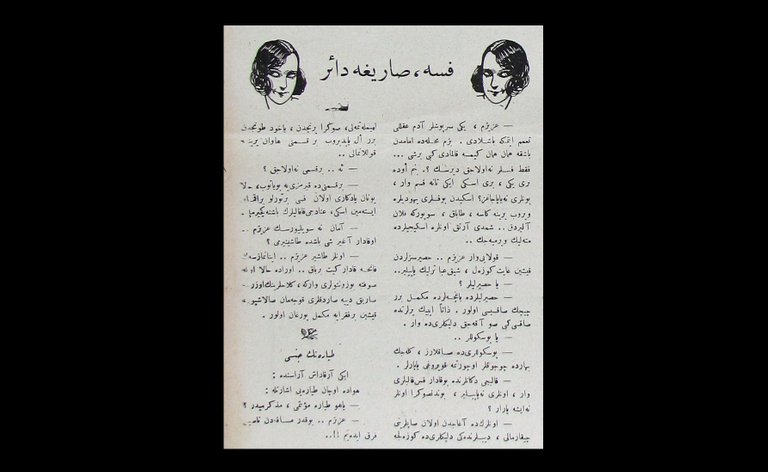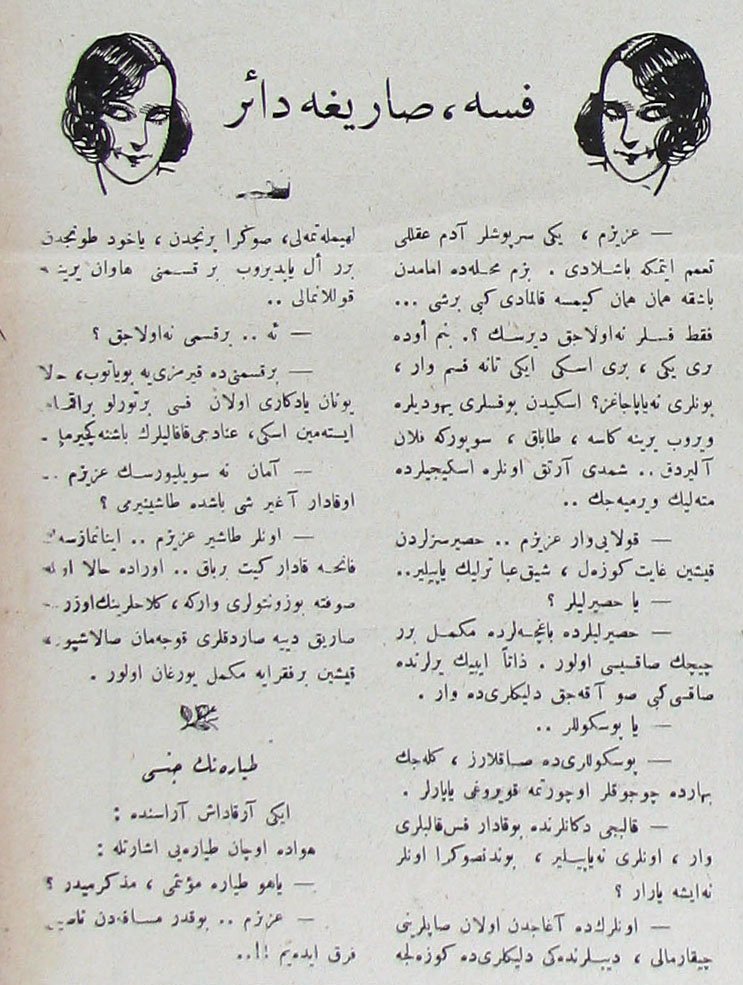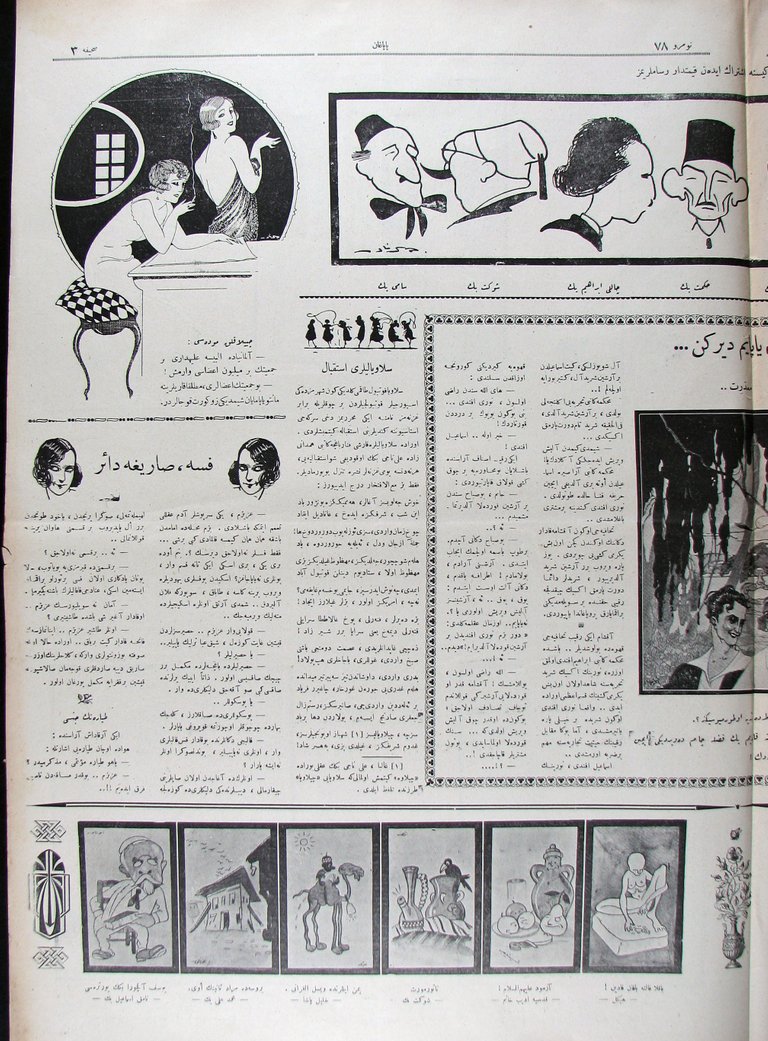
(Humorous dialogue, Papağan or “Parrot,” 5 August 1925, no. 78, page 3.)
Türkçe
Fese, Sarığa Dair
— Azizim, yeni şapkalar adam akıllı taammüm etmeğe başladı. Bizim mahallede imamdan başka hemen hemen kimse kalmadı gibi bir şey… Fakat fesler ne olacak dersin? Benim evde biri yeni, biri eski iki tane fesim var, bunları ne yapacağız? Eskiden bu fesleri Yahudilere verip yerine kase, tabak, süpürge filan alırdık… Şimdi artık onlara eskiciler de [متهلیک] vermeyecek…
— Kolayı var azizim… hasırsızlardan kışın gayet güzel, şık aba terlik yapılır…
— Ya hasırlılar?
— Hasırlılar da bahçelerde mükemmel birer çiçek saksısı olur. Zaten [اییک] yerlerinde saksı gibi su akacak delikleri de var.
— Ya püsküller...
— Püskülleri de saklarız, gelecek baharda çocuklar uçurtma kuyruğu yaparlar.
— Kalıpçı dükkanlarında bu kadar fes kalıpları var, onları ne yapılır, bundan sonra onlar ne işe yarar?
— Onların da ağaçtan olan saplarını çıkarmalı, diplerindeki delikleri de güzelce lehimletmeli, sonra pirinçten, yahud tunçtan birer el yaptırıp bir kısmını havan yerine kullanmalı…
— Eee… Bir kısmı ne olacak?
— Bir kısmını da kırmızıya boyatıp, hala Yunan yadigarı olan fesi bir türlü bırakmayı istemeyen eski, inatçı kafalıların başına geçirmeli.
— Aman ne söylüyorsun azizim… O kadar ağır şey başta taşınır mı?
— Onlar taşır azizim… İnanmazsan Fatih’e kadar git bir bak… Orada hala o softa bozuntuları var ki, külahlarının üzerine sarık diye sardıkları kocaman salaşpur kışın bir fukaraya mükemmel yorgan olur.
English
On Fezzes and Turbans
— My dear, the new hats have really started spreading. Besides the imam almost nobody remains in our neighborhood (without the new hat). But what do you think will happen to the fezzes? I have two fezzes—one new one old—at home, what are we going to do with these? We used to give these fezzes to the Jews and would get something like a bowl, plate, or broom in return… Now even the junk-dealers won’t give [متهلیک] for them…
— There’s a simple solution my dear… Beautiful, chic winter slippers can be made from the unmatted ones.
— What about the matted ones?
— The matted ones will make perfect pots for the garden. They already have holes for the water to run out in the place of their [اییک].
— What about their tassels…
— We’ll save the tassels; next Spring the children will make kite tails out of them.
— What should be done with all of the fez molds in the molder’s shop? From now on what will their use be?
— Their tree stems must be removed and the holes at their bases nicely soldered. Then for each a handle will be made of brass or bronze so that some of them will be used as (pounding) mortars.
— And what will come of the rest of them?
— The rest should be painted red placed on the heads of those old, stubborn-minded people who still refuse to let go of the fez which is a relic from the Greeks.
— What are you saying my dear… How can such a heavy thing be carried on the head?
— They will carry it my friend… If you don’t believe it go to Fatih and take a look around… Those corrupt religious fanatics are still there… those gigantic linen fabrics that they wrap around their conical caps to create turbans would make perfect blankets for the poor in winter.
Comments:
Both of today’s posts share the same page in the satiricl journal Papağan. The dialogue about headgear reflects common rhetoric in the build up to the famous/infamous hat law which would pass later that year, on 25 November 1925. Hat reform made it illegal for Turkish citizens to wear the fez (considered to be a symbol of the old Ottoman order) and the turban (sarık) unless they were officially recognized imams or religious clerics. On 2 August 1925 government officials were required to abandon their fezzes in favor of Western-style hats. Thus, this recent development is the context for this dialogue which opens with observations on how quickly the new hats have been “adopted.” Yet, by the end of the conversation it is revealed that conservative districts such as Fatih still maintained a substantial population who continued to wear fezzes and turbans.
Several subversions of the fez occur in this dialogue. To start, by concocting a whole list of lesser functions that the headdress could perform if it were re-purposed (rather than discarded) the author effectively devalues the fez. By suggesting that fezzes could be made into slippers the author removes the fez from the esteemed location of the head to the significantly less glamorous region of the foot. As shoes, the fezzes obsolescence is reaffirmed every time it is stomped upon. A similar casual insult is made with the suggestion that unused fezzes could be recycled into planters. This brief text also manages to associate the wearers of fezzes and turbans with what were considered to be undesirable types such as Greeks (recent enemies of the Turks from the battlefields of the War of Independence) and Muslim religious fanatics. In this way, the text reflects a Turkish nationalist and a pro-secularist ideological position.
The subject of hat reform, in its many facets, has been considered in previous Today in 1920s Turkey posts. These posts can be found below:
138. Today in 1920s Turkey: 30 January 1926 (Discarded Fezzes: Collectibles for Tourists)
38. Today in 1920s Turkey: 12 December 1925 (Bird-Brained Bigot or Principled Protester?)
18. Today in 1920s Turkey: 10 September 1925 (Oldest Man Alive is also Modern)
This article has been updated and modified from its first iteration published right here on Steemit on 5 August 2016. For the original version see:
4. Today in 1920s Turkey: 5 August 1925 (Fezzes, Turbans, and Planes)
(Entire page, Papağan or “Parrot,” 5 August 1925, no. 78, page 3.)

